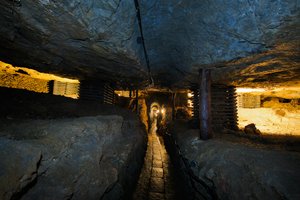Krzemionki prehistoric striped flint mining region
At the 43rd Session of the World Heritage Committee held in Baku, Azerbaijan, Poland's Krzemionki prehistoric striped flint mining region was added to UNESCO's World Heritage List.
The Krzemionki Prehistoric Striped Plint Mining Region, or Krzemionki Opatowskie, located in the mountain region of Świętokrzyskie in southern Poland, is an ensemble of four mining sites, dating from the Neolithic to the early Bronze Age (ca. 3900 to 1600 BCE). The site was dedicated to the extraction and processing of striped flint, which was mainly used for the production of simple tools such as axeheads.
"With its underground mining structures, flint workshops and some 4,000 shafts and pits, the site features one of the most comprehensive prehistoric underground flint extraction and processing systems identified to date. The site provides information about life and work in prehistoric settlements and bears witness to an extinct cultural tradition. It is an exceptional testimony of the importance of the prehistoric period and of flint mining for tool production in human histor" (UNESCO).
The Krzemionki mines were discovered by Prof. Jan Samsonowicz, a Polish geologist, in 1922. The significance of Samsonowicz’s discovery was soon realised and Krzemionki were soon recognized a historical treasure.
Poland nominated the Krzemionki Prehistoric Striped Plint Mining Region for inscription on UNESCO’s World Heritage List in early 2018, and later in the year an ICOMOS expert visited the site and gave a positive recommendation. The decision to add Krzemionki Opatowskie to the World Heritage List was made during the 43. session of the World Heritage Committee held in Baku (Azerbaijan).
The Krzemionki mining complex is the sixteenth site in Poland included in the World Heritage List.
Poland.pl
08.07.2019







